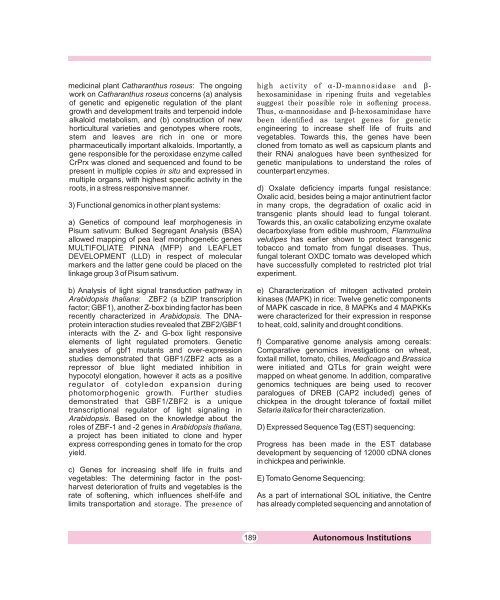ANNUAL REPORT - Department of Biotechnology
ANNUAL REPORT - Department of Biotechnology
ANNUAL REPORT - Department of Biotechnology
Create successful ePaper yourself
Turn your PDF publications into a flip-book with our unique Google optimized e-Paper software.
medicinal plant Catharanthus roseus: The ongoing<br />
work on Catharanthus roseus concerns (a) analysis<br />
<strong>of</strong> genetic and epigenetic regulation <strong>of</strong> the plant<br />
growth and development traits and terpenoid indole<br />
alkaloid metabolism, and (b) construction <strong>of</strong> new<br />
horticultural varieties and genotypes where roots,<br />
stem and leaves are rich in one or more<br />
pharmaceutically important alkaloids. Importantly, a<br />
gene responsible for the peroxidase enzyme called<br />
CrPrx was cloned and sequenced and found to be<br />
present in multiple copies in situ and expressed in<br />
multiple organs, with highest specific activity in the<br />
roots, in a stress responsive manner.<br />
3) Functional genomics in other plant systems:<br />
a) Genetics <strong>of</strong> compound leaf morphogenesis in<br />
Pisum sativum: Bulked Segregant Analysis (BSA)<br />
allowed mapping <strong>of</strong> pea leaf morphogenetic genes<br />
MULTIFOLIATE PINNA (MFP) and LEAFLET<br />
DEVELOPMENT (LLD) in respect <strong>of</strong> molecular<br />
markers and the latter gene could be placed on the<br />
linkage group 3 <strong>of</strong> Pisum sativum.<br />
b) Analysis <strong>of</strong> light signal transduction pathway in<br />
Arabidopsis thaliana: ZBF2 (a bZIP transcription<br />
factor; GBF1), another Z-box binding factor has been<br />
recently characterized in Arabidopsis. The DNAprotein<br />
interaction studies revealed that ZBF2/GBF1<br />
interacts with the Z- and G-box light responsive<br />
elements <strong>of</strong> light regulated promoters. Genetic<br />
analyses <strong>of</strong> gbf1 mutants and over-expression<br />
studies demonstrated that GBF1/ZBF2 acts as a<br />
repressor <strong>of</strong> blue light mediated inhibition in<br />
hypocotyl elongation, however it acts as a positive<br />
regulator <strong>of</strong> cotyledon expansion during<br />
photomorphogenic growth. Further studies<br />
demonstrated that GBF1/ZBF2 is a unique<br />
transcriptional regulator <strong>of</strong> light signaling in<br />
Arabidopsis. Based on the knowledge about the<br />
roles <strong>of</strong> ZBF-1 and -2 genes in Arabidopsis thaliana,<br />
a project has been initiated to clone and hyper<br />
express corresponding genes in tomato for the crop<br />
yield.<br />
c) Genes for increasing shelf life in fruits and<br />
vegetables: The determining factor in the postharvest<br />
deterioration <strong>of</strong> fruits and vegetables is the<br />
rate <strong>of</strong> s<strong>of</strong>tening, which influences shelf-life and<br />
limits transportation and storage. The presence <strong>of</strong><br />
189<br />
high activity <strong>of</strong> α-D-mannosidase and βhexosaminidase<br />
in ripening fruits and vegetables<br />
suggest their possible role in s<strong>of</strong>tening process.<br />
Thus, α-mannosidase and β-hexosaminidase have<br />
been identified as target genes for genetic<br />
engineering to increase shelf life <strong>of</strong> fruits and<br />
vegetables. Towards this, the genes have been<br />
cloned from tomato as well as capsicum plants and<br />
their RNAi analogues have been synthesized for<br />
genetic manipulations to understand the roles <strong>of</strong><br />
counterpart enzymes.<br />
d) Oxalate deficiency imparts fungal resistance:<br />
Oxalic acid, besides being a major antinutrient factor<br />
in many crops, the degradation <strong>of</strong> oxalic acid in<br />
transgenic plants should lead to fungal tolerant.<br />
Towards this, an oxalic catabolizing enzyme oxalate<br />
decarboxylase from edible mushroom, Flammulina<br />
velutipes has earlier shown to protect transgenic<br />
tobacco and tomato from fungal diseases. Thus,<br />
fungal tolerant OXDC tomato was developed which<br />
have successfully completed to restricted plot trial<br />
experiment.<br />
e) Characterization <strong>of</strong> mitogen activated protein<br />
kinases (MAPK) in rice: Twelve genetic components<br />
<strong>of</strong> MAPK cascade in rice, 8 MAPKs and 4 MAPKKs<br />
were characterized for their expression in response<br />
to heat, cold, salinity and drought conditions.<br />
f) Comparative genome analysis among cereals:<br />
Comparative genomics investigations on wheat,<br />
foxtail millet, tomato, chilies, Medicago and Brassica<br />
were initiated and QTLs for grain weight were<br />
mapped on wheat genome. In addition, comparative<br />
genomics techniques are being used to recover<br />
paralogues <strong>of</strong> DREB (CAP2 included) genes <strong>of</strong><br />
chickpea in the drought tolerance <strong>of</strong> foxtail millet<br />
Setaria italica for their characterization.<br />
D) Expressed Sequence Tag (EST) sequencing:<br />
Progress has been made in the EST database<br />
development by sequencing <strong>of</strong> 12000 cDNA clones<br />
in chickpea and periwinkle.<br />
E) Tomato Genome Sequencing:<br />
As a part <strong>of</strong> international SOL initiative, the Centre<br />
has already completed sequencing and annotation <strong>of</strong><br />
Autonomous Institutions

















